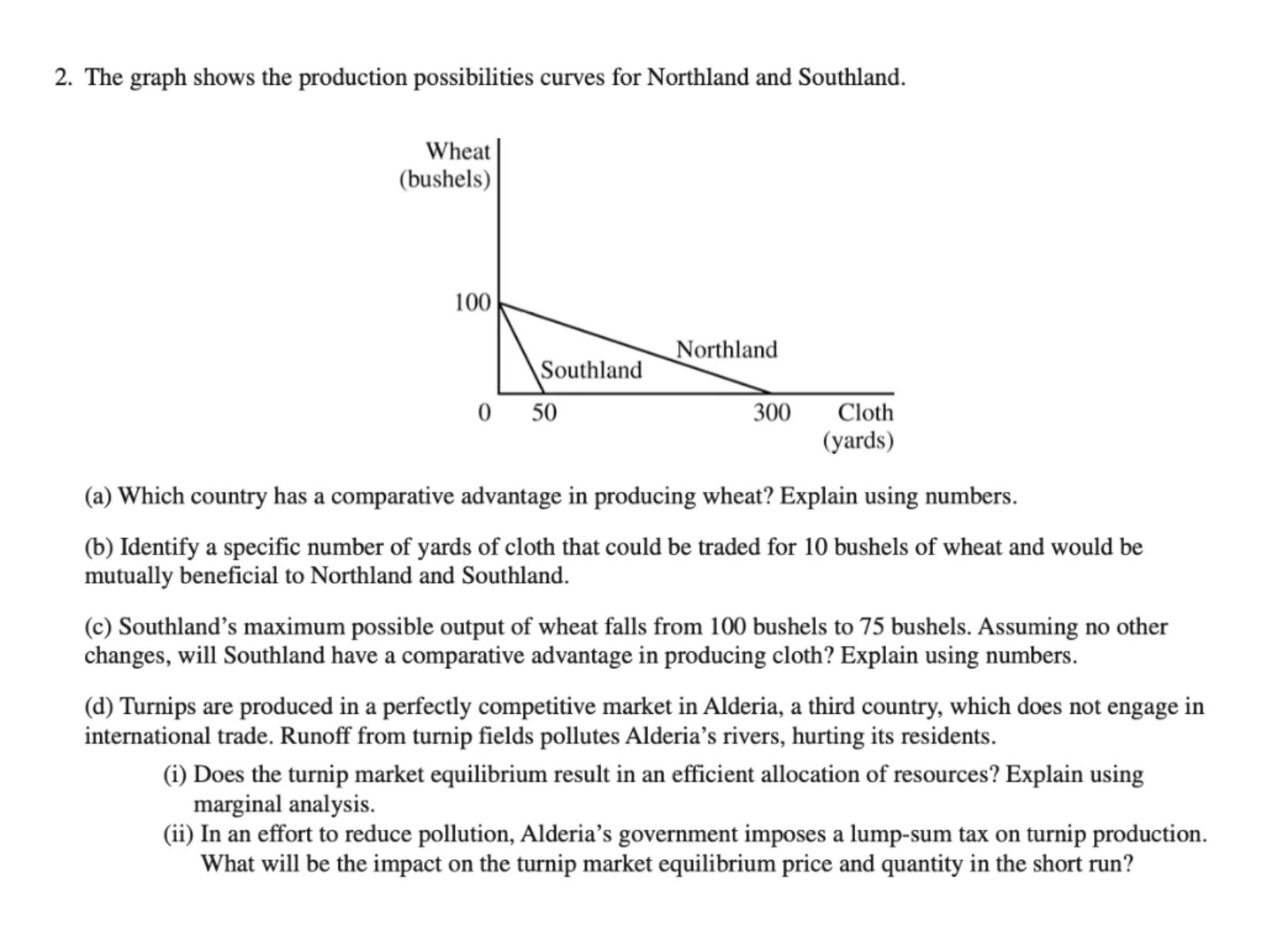
Sia
this is great
as detail as possible
2. The graph shows the production possibilities curves for Northland and Southland.
(a) Which country has a comparative advantage in producing wheat? Explain using numbers.
(b) Identify a specific number of yards of cloth that could be traded for 10 bushels of wheat and would be mutually beneficial to Northland and Southland.
(c) Southland's maximum possible output of wheat falls from 100 bushels to 75 bushels. Assuming no other changes, will Southland have a comparative advantage in producing cloth? Explain using numbers.
(d) Turnips are produced in a perfectly competitive market in Alderia, a third country, which does not engage in international trade. Runoff from turnip fields pollutes Alderia's rivers, hurting its residents.
(i) Does the turnip market equilibrium result in an efficient allocation of resources? Explain using marginal analysis.
(ii) In an effort to reduce pollution, Alderia's government imposes a lump-sum tax on turnip production. What will be the impact on the turnip market equilibrium price and quantity in the short run?

Answer from Sia
Posted over 1 year ago
2a Solution
a
Comparative Advantage in Wheat: Comparative advantage is determined by the opportunity cost of producing one good over another. For Southland, the opportunity cost of producing one bushel of wheat is yards of cloth. For Northland, the opportunity cost of producing one bushel of wheat is yards of cloth. Since Southland's opportunity cost is lower, it has a comparative advantage in producing wheat
2a Answer
Southland has a comparative advantage in producing wheat.
Key Concept
Comparative advantage is determined by the lower opportunity cost.
Explanation
Southland has a lower opportunity cost for producing wheat compared to Northland, indicating its comparative advantage in wheat production.
2b Solution
b
Mutually Beneficial Trade: To find a mutually beneficial trade, the trade must occur at an opportunity cost between the two countries' opportunity costs for producing cloth. Since Southland's opportunity cost of producing cloth is 2 bushels of wheat per yard of cloth () and Northland's is bushel of wheat per yard of cloth (), any trade ratio between and 2 bushels of wheat per yard of cloth would be beneficial. For 10 bushels of wheat, a mutually beneficial trade could be 5 yards of cloth, as it falls between the two opportunity costs
2b Answer
A mutually beneficial trade for 10 bushels of wheat could be 5 yards of cloth.
Key Concept
Mutually beneficial trade occurs when the trade ratio is between the two countries' opportunity costs.
Explanation
The trade of 5 yards of cloth for 10 bushels of wheat benefits both countries as it falls between their respective opportunity costs for producing cloth.
2c Solution
c
Comparative Advantage in Cloth After Wheat Output Falls: After Southland's maximum possible output of wheat falls to 75 bushels, its opportunity cost of producing one yard of cloth becomes bushels of wheat. Northland's opportunity cost remains bushel of wheat per yard of cloth. Since Northland's opportunity cost for producing cloth is still lower than Southland's, even after the change, Southland does not have a comparative advantage in producing cloth
2c Answer
Southland does not have a comparative advantage in producing cloth after its maximum wheat output falls.
Key Concept
Comparative advantage remains with the country that has the lower opportunity cost after changes in production capabilities.
Explanation
Despite the decrease in wheat production, Southland's opportunity cost for producing cloth is still higher than Northland's, so it does not gain a comparative advantage in cloth.
2d(i) Solution
d(i)
Market Equilibrium and Efficiency: The market equilibrium in a perfectly competitive market is efficient if all externalities are internalized. Since the runoff from turnip fields creates a negative externality that is not reflected in the market price, the market equilibrium does not result in an efficient allocation of resources. Marginal social cost (MSC) is greater than marginal private cost (MPC), leading to overproduction of turnips
2d(i) Answer
The turnip market equilibrium does not result in an efficient allocation of resources due to the negative externality of pollution.
Key Concept
Market equilibrium is not efficient when negative externalities are present.
Explanation
The presence of a negative externality, such as pollution, means that the social cost of production is higher than the private cost, leading to overproduction and inefficiency.
2d(ii) Solution
d(ii)
Impact of Lump-Sum Tax on Market Equilibrium: A lump-sum tax on turnip production will increase the cost of production for turnip producers, shifting the supply curve to the left. This will result in a higher equilibrium price and a lower equilibrium quantity in the short run
2d(ii) Answer
The imposition of a lump-sum tax on turnip production will lead to a higher market equilibrium price and a lower quantity in the short run.
Key Concept
A lump-sum tax shifts the supply curve to the left, affecting price and quantity.
Explanation
The tax increases production costs, leading to a decrease in supply, which raises the price and reduces the quantity sold in the market.
Not the question you are looking for? Ask here!
Enter question by text
Enter question by image
Unlock Smarter Learning with AskSia Super!
Join Super, our all-in-one AI solution that can greatly improve your learning efficiency.
30% higher accuracy than GPT-4o
Entire learning journey support
The most student-friendly features
Study Other Question
